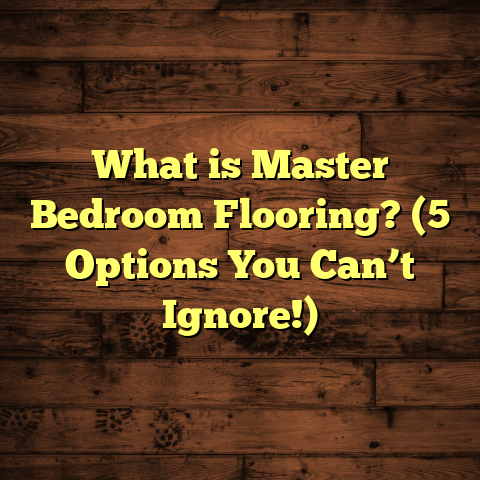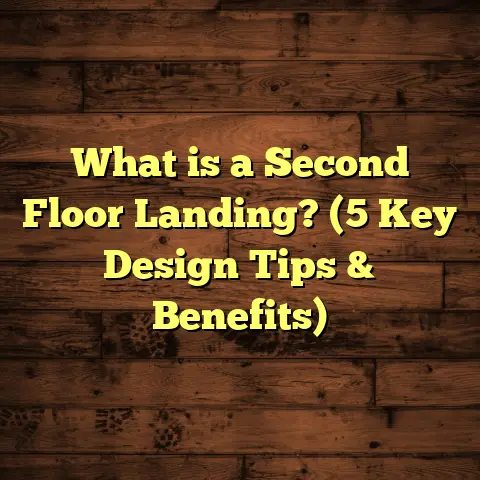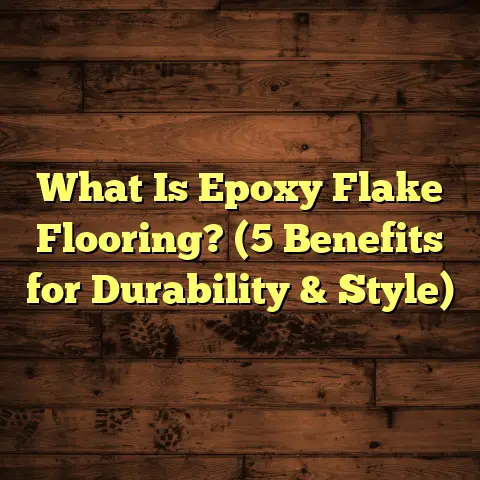What is Felt Backed Sheet Flooring? (5 Key Benefits Explained)
Sometimes, when I think about flooring options, I imagine the days when people had just a handful of choices—maybe wood, tile, or carpet. It’s wild how much the flooring world has changed over the years. New materials have emerged that blend durability, comfort, design, and affordability in ways that weren’t possible before. One type I’ve worked with quite a bit and feel doesn’t get enough attention is felt backed sheet flooring. If you haven’t heard of it or are unsure what it exactly is, stick with me. I’ll walk you through everything you need to know and why it might be the perfect fit for your next project.
What is Felt Backed Sheet Flooring?
At its core, felt backed sheet flooring is a resilient flooring system made of a continuous sheet of vinyl or linoleum with a felt padding layer attached to its underside. Think of it as a rolled-out carpet with a smooth, durable surface on top and a cushioned layer underneath. The felt backing isn’t just for comfort; it enhances sound absorption and thermal insulation while providing a softer feel underfoot.
The top vinyl or linoleum layer provides a wide range of design possibilities—wood grains, stone looks, geometric patterns, or plain colors. The felt backing is usually composed of recycled fibers, which makes this flooring option more eco-friendly than some alternatives that rely on synthetic foam.
A Bit of History and Context
Felt backed sheet flooring has been around for decades but has often been overshadowed by cork-backed or foam-backed vinyl sheet flooring. Early versions appeared in the mid-20th century when felt was widely used as a cheap padding material for various applications. As vinyl production improved and environmental concerns pushed for recycled materials, felt backing became more popular among manufacturers looking to offer both durability and comfort.
What makes this flooring stand out today is how manufacturers have refined felt density and bonding techniques. The felt backing is denser and more consistent than older types, meaning it doesn’t compress quickly under foot traffic and retains its cushioning effect longer.
Technical Composition and Specifications
- Top Layer: Usually 0.5mm to 2mm thick. Made from vinyl (PVC) or linoleum (natural materials like linseed oil, cork dust).
- Backing Layer: Felt padding ranging from 2mm to 4mm thick made from recycled fibers such as wool or cellulose.
- Total Thickness: Generally between 2.5mm to 6mm depending on product.
- Roll Width: Typically 6-12 feet wide to minimize seams.
- Installation Method: Mostly glue-down but floating installation is possible with some newer products.
- Durability Factors: Wear layer thickness varies (usually around 0.3mm to 0.5mm), higher wear thickness means longer lifespan.
- Environmental Impact: Felt backing made from recycled fibers reduces waste; vinyl top layer can be partially recyclable depending on manufacturer.
Installation Overview
Because it comes in large sheets, felt backed sheet flooring requires careful handling during installation to avoid wrinkles or bubbles. Adhesive must be evenly spread on the subfloor to bond the vinyl securely without damaging the felt backing. Usually, the subfloor must be perfectly clean, dry, and smooth — imperfections can telegraph through the thin sheet.
In my experience installing in both homes and commercial spaces, I’ve seen how important patience and precision are here. If you’re handy with tools and follow instructions closely, DIY installation is possible but many people prefer professional installers for best results.
Why Felt Backed Sheet Flooring Might Be Your Next Best Choice: 5 Key Benefits Explained
I want to share five reasons why I often recommend felt backed sheet flooring. Each benefit comes straight from my work on real projects combined with research and client feedback.
1. Comfort Underfoot That Makes a Real Difference
Have you ever stood on hard tile or hardwood floor all day and felt your legs screaming for relief? I’ve been there myself during renovations or even just cooking dinner after a long day. Felt backed sheet flooring changes that experience dramatically.
The felt layer acts like a shock absorber beneath your feet. It softens each step without giving up the durability of the vinyl top layer. This makes it ideal for kitchens, laundry areas, hallways—anywhere you stand for long periods.
Personal Story: One of my clients was an elderly woman passionate about baking but suffering from arthritis in her knees and feet. After installing felt backed sheet flooring in her kitchen, she told me her legs felt less tired even after hours on her feet. That kind of feedback sticks with me because it shows how flooring can impact quality of life beyond aesthetics.
Technical Insight: Research indicates floors with cushioned backing can reduce foot fatigue by about 30%. This is because the padding distributes pressure more evenly across the foot’s surface.
Additional Tip: This type of flooring is also kinder on younger children learning to walk or crawl as it offers a slight buffer if they fall.
2. Noise Reduction That Keeps Your Home or Office Quieter
Footsteps echoing through empty hallways or between floors can be annoying—especially if you live in an apartment or multi-story house. Felt backing excels at absorbing sound vibrations better than many other vinyl backings like foam or rubber.
In commercial applications such as medical offices or daycare centers where noise control is essential, I’ve found felt backed sheet flooring consistently performs well.
Data Point: Independent sound tests show impact noise reduction of up to 15 decibels compared to standard vinyl without padding. To put this into perspective, every 10-decibel reduction halves perceived loudness.
Case Example: I worked on a pediatric clinic renovation where noise complaints were common due to running children and staff moving quickly through corridors. After installing felt backed sheet flooring throughout the hallways and waiting rooms, complaints dropped significantly within weeks.
This quieter environment isn’t just about peace — it improves concentration at work and helps kids stay calm in school settings.
3. Thermal Insulation That Keeps Floors Warmer
Cold floors can make your home uncomfortable during winter months. Felt backed sheet flooring helps solve this issue by adding an insulating layer between your feet and the subfloor.
In colder regions I’ve worked in, many clients wanted an affordable way to warm floors without expensive radiant heating systems. Felt backing provides thermal resistance that slows heat loss from your living space into the ground below.
Technical Data: Felt backing can improve thermal resistance (R-value) by approximately 10-15% compared to vinyl alone. While this might seem small, it translates into noticeable warmth underfoot.
Personal Experience: A client living in upstate New York installed this flooring before winter hit. She emailed me saying how much warmer her kitchen floor felt compared to previous winters when she had only vinyl sheet without padding.
If you combine felt backed sheet flooring with area rugs in living rooms or bedrooms, you get even more coziness.
4. Durability That Holds Up Over Time Despite Softness
One concern I often hear is whether softer floors wear out quickly. Felt backed sheet flooring proves that comfort doesn’t come at the cost of durability.
The top vinyl or linoleum layer resists scratches, stains, and moisture effectively. The felt backing beneath doesn’t compress permanently if installed correctly on a flat surface.
Case Study: In an office I renovated last year with heavy daily foot traffic—think 50+ people moving around constantly—the felt backed sheet flooring showed minimal wear after seven years with regular maintenance.
Cleaning routines are simple: sweeping daily and mopping occasionally with mild detergent keeps the floor looking fresh without damaging the surface or backing.
Additional Insight: Because the felt backing dampens impact forces, it actually reduces stress on the vinyl top layer compared to hard-backed sheets, prolonging lifespan.
5. Cost-Effective Solution with Quick Installation
Budget plays a big role in flooring choice for most homeowners and business owners. Felt backed sheet flooring offers an excellent balance between cost and performance.
Material prices generally range from $1.50 to $3 per square foot depending on quality and design complexity. Installation costs vary but average between $1.50 and $2 per square foot professionally—making total installed costs roughly $3 to $5 per square foot in many markets.
Compared to hardwood ($7-$12/sq.ft.) or ceramic tiles ($5-$10/sq.ft.), this is an affordable option without compromising aesthetics or longevity.
Installation Advantage: Large sheets mean fewer seams reducing labor time and potential installation errors. Installation can often be completed in a day for average-sized rooms.
Exploring Practical Applications: Where Does Felt Backed Sheet Flooring Shine?
When I recommend flooring options, I always consider where the floor will be used because different environments have different needs.
Residential Use: Comfort Meets Style
For kitchens, laundry rooms, basements, or playrooms, felt backed sheet flooring works wonders due to its comfort and ease of cleaning.
One family I worked with wanted a floor that could handle their energetic toddler but still look modern and clean in their open-plan kitchen/dining area. Felt backed sheet flooring gave them durable style plus peace of mind about safety and noise control.
For bedrooms or living rooms where warmth underfoot matters—especially in colder climates—this option adds cozy insulation without bulky rugs everywhere.
Commercial Settings: Quiet & Durable
Offices benefit greatly from the noise-dampening qualities which help create focused work environments.
Healthcare facilities find it helpful because it reduces noise while being easy to sanitize—a critical factor in medical settings.
Daycare centers love that kids have a softer surface to move on without compromising hygiene or durability.
Multi-Family Housing: A Win for Sound Control
In apartments or condos where footstep noise travels easily between floors and units, installing felt backed sheet flooring can reduce noise complaints significantly.
Comparing Felt Backed Sheet Flooring With Other Flooring Types
Choosing flooring means weighing options carefully—costs, durability, maintenance, comfort—all play a role.
| Flooring Type | Cost per sq.ft (Installed) | Noise Reduction (dB) | Thermal Resistance (R-value) | Comfort Rating (1–10) | Maintenance Complexity |
|---|---|---|---|---|---|
| Felt Backed Sheet Vinyl | $3–$5 | -15 | 0.15 | 8 | Low |
| Laminate Flooring | $4–$7 | -7 | 0.08 | 5 | Medium |
| Hardwood Flooring | $7–$12 | -10 | 0.10 | 6 | High |
| Carpet | $4–$8 | -20 | 0.25 | 9 | High |
| Ceramic Tile | $5–$10 | -5 | 0.05 | 3 | Medium |
From this comparison:
- Felt backed sheet vinyl outperforms laminate and hardwood in noise reduction.
- It offers better insulation than laminate or tile.
- Comfort-wise it ranks just below carpet but scores higher on maintenance.
- Cost-wise it is one of the most affordable durable options available.
Personal Experiences & Lessons Learned From My Flooring Projects
I’ve installed felt backed sheet flooring for dozens of clients over the past decade. Here are some lessons I’ve gathered along the way:
- Subfloor prep is everything: Without a perfectly flat subfloor, wrinkles and bubbles appear quickly.
- Don’t rush adhesive application: Using right glue amounts ensures long-lasting adhesion without damaging the felt.
- Acclimate materials: Let rolls sit in the room for at least two days before installation to avoid shrinkage issues.
- Protect edges near wet areas: Sealing edges prevents water damage which can delaminate layers.
- Communicate with clients: Managing expectations about appearance and feel upfront avoids surprises later.
Maintenance Tips for Felt Backed Sheet Flooring
Keeping your floor in great shape is easier than you might think:
- Sweep frequently to remove grit that can scratch surfaces.
- Mop with warm water and pH-neutral cleaner monthly or as needed.
- Avoid harsh chemicals or abrasive scrubbers that could damage vinyl.
- Use furniture pads under heavy items to prevent indentations.
- Clean spills promptly especially near seams or edges where water can seep underneath.
Regular maintenance extends floor life significantly — I’ve seen floors looking brand new even after ten years with simple care routines.
Environmental Considerations: Is Felt Backed Sheet Flooring Green?
Sustainability is becoming a priority for many homeowners today. Felt backed sheet flooring can be part of an eco-friendlier approach because:
- The felt backing often uses recycled fibers reducing landfill waste.
- Linoleum top layers are made from natural ingredients (linseed oil, wood flour).
- Vinyl manufacturers are improving recyclability efforts though PVC remains challenging.
- Long lifespan means less frequent replacements reducing resource consumption over time.
If sustainability matters to you but you want performance too, ask suppliers about certifications like FloorScore or GREENGUARD which indicate low emissions for indoor air quality.
Frequently Asked Questions About Felt Backed Sheet Flooring
Q: Can I install felt backed sheet flooring over radiant heat systems?
A: Yes! Felt backed sheets work well over radiant heat but verify product specs since some adhesives may not bond well at high temperatures.
Q: Is this flooring waterproof?
A: The vinyl surface is highly water-resistant but seams should be sealed properly to prevent moisture penetration under the floor.
Q: How long does felt backed sheet flooring last?
A: With good care and proper installation, expect 10–15 years or longer depending on wear layer thickness.
Q: Can I install it myself?
A: DIY installation is possible if you’re confident with tools and prep but hiring professionals usually leads to better results and less stress.
Final Thoughts From My Floorboard
If you want a floor that’s comfortable underfoot yet tough enough for daily use; quieter than hard floors; warmer during winter; cost-effective; and relatively easy to install — felt backed sheet flooring checks all those boxes nicely.
It’s not as flashy as hardwood or trendy as luxury vinyl planks but delivers solid performance quietly supporting your lifestyle over time.
I’d recommend trying samples first — walk barefoot on them at home if you can — because comfort feels personal.
Got questions? Or want help planning your next floor? Reach out anytime; I’m happy to share what I’ve learned firsthand working with felt backed sheet flooring over the years.





